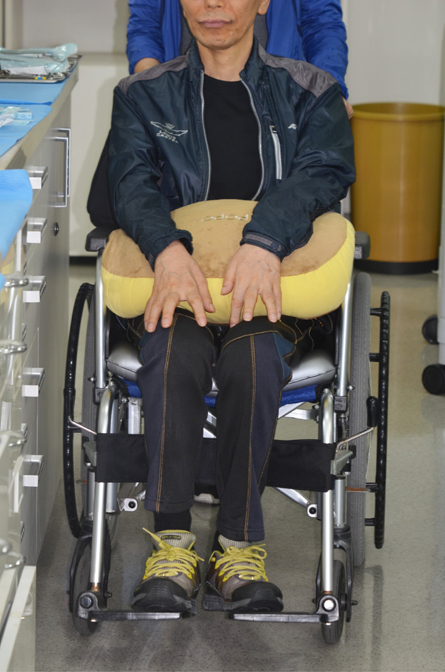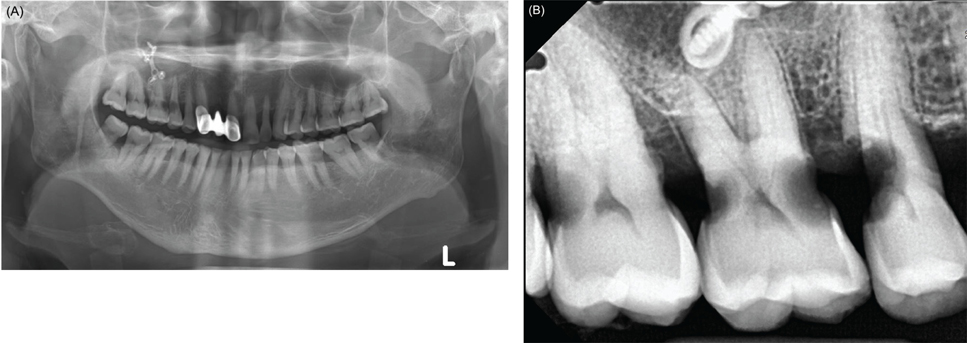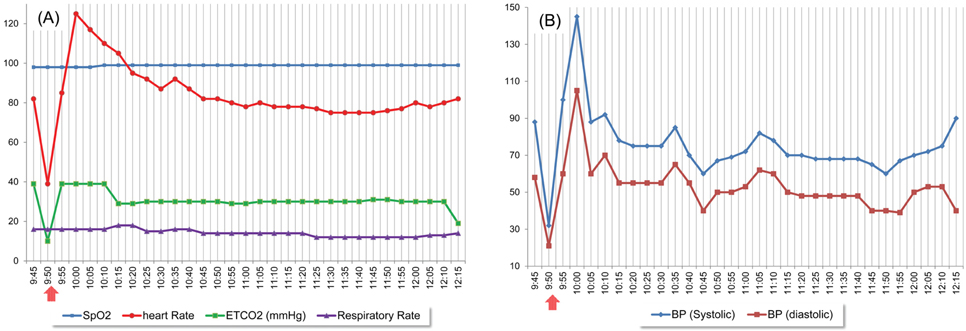J Dent Anesth Pain Med.
2017 Sep;17(3):235-240. 10.17245/jdapm.2017.17.3.235.
Pulseless electrical activity during general anesthesia induction in patients with amyotrophic lateral sclerosis
- Affiliations
-
- 1Department of Advanced General Dentistry, School of Dentistry, Dankook University, Cheonan, Korea.
- 2Department of Anesthesiology, School of Dentistry, Dankook University, Cheonan, Korea. ksomd@dankook.ac.kr
- KMID: 2390810
- DOI: http://doi.org/10.17245/jdapm.2017.17.3.235
Abstract
- Pulseless electrical activity (PEA) is a clinical condition characterized by unresponsiveness and lack of palpable pulse in the presence of organized cardiac electrical activity and is caused by a profound cardiovascular insult (e.g., severe prolonged hypoxia or acidosis, extreme hypovolemia, or flow-restricting pulmonary embolus). Amyotrophic lateral sclerosis (ALS) is a disease that is characterized by progressive degeneration of all levels of the motor nervous system. Damage to the respiratory system and weakness of the muscles may increase the likelihood of an emergency situation occurring in patients with ALS while under general anesthesia. We report a case of PEA during the induction of general anesthesia in a patient with ALS who presented for dental treatment and discuss the causes of PEA and necessary considerations for general anesthesia in patients with ALS.
MeSH Terms
Figure
Cited by 1 articles
-
Cardiac arrest due to an unexpected acute myocardial infarction during head and neck surgery: A case report
Jimin Kim, Eunsun So, Hyun Jeong Kim, Kwang-Suk Seo, Myong-Hwan Karm
J Dent Anesth Pain Med. 2018;18(1):57-64. doi: 10.17245/jdapm.2018.18.1.57.
Reference
-
1. Myerburg RJ, Halperin H, Egan DA, Boineau R, Chugh SS, Gillis AM, et al. Pulseless electric activity: definition, causes, mechanisms, management, and research priorities for the next decade: report from a National Heart, Lung, and Blood Institute workshop. Circulation. 2013; 128:2532–2541.2. Attin M, Tucker RG, Carey MG. In-Hospital Cardiac Arrest: An Update on Pulseless Electrical Activity and Asystole. Crit Care Nurs Clin North Am. 2016; 28:387–397.3. Link MS, Berkow LC, Kudenchuk PJ, Halperin HR, Hess EP, Moitra VK, et al. Part 7: Adult Advanced Cardiovascular Life Support: 2015 American Heart Association Guidelines Update for Cardiopulmonary Resuscitation and Emergency Cardiovascular Care. Circulation. 2015; 132:18 Suppl 2. S444–S464.4. Kiernan MC, Vucic S, Cheah BC, Turner MR, Eisen A, Hardiman O, et al. Amyotrophic lateral sclerosis. Lancet. 2011; 377:942–955.
Article5. Zarei S, Carr K, Reiley L, Diaz K, Guerra O, Altamirano PF, et al. A comprehensive review of amyotrophic lateral sclerosis. Surg Neurol Int. 2015; 6:171.
Article6. Trivedi S, Tibrewala N, Balsara KP. Anaesthetic management of a patient with amyotrophic lateral sclerosis undergoing laparoscopic diaphragmatic pacing. Indian J Anaesth. 2015; 59:683–685.
Article7. Prabhakar A, Owen CP, Kaye AD. Anesthetic management of the patient with amyotrophic lateral sclerosis. J Anesth. 2013; 27:909–918.
Article8. Kim HS, Lee SY, Choi EH, Kim SO. Anesthetic Management of an Amyotrophic Lateral Sclerosis Patient Undergoing Dental Care in Daysurgery Center. J Korean Dent Soc Anesthesiol. 2013; 13:195–201.
Article9. Gabrielli A, O'Connor MF, Maccioli GA. Anesthesia advanced circulatory life support. Committee on Critical Care Medicine;2008.10. Moitra VK, Gabrielli A, Maccioli GA, O'Connor MF. Anesthesia advanced circulatory life support. Can J Anaesth. 2012; 59:586–603.
Article11. Mehta C, Brady W. Pulseless electrical activity in cardiac arrest: electrocardiographic presentations and management considerations based on the electrocardiogram. Am J Emerg Med. 2012; 30:236–239.
Article12. Murata Y, Harada T, Ishizaki F, Izumi Y, Nakamura S. An abnormal relationship between blood pressure and pulse rate in amyotrophic lateral sclerosis. Acta Neurol Scand. 1997; 96:118–122.
Article13. Asai H, Hirano M, Udaka F, Shimada K, Oda M, Kubori T, et al. Sympathetic disturbances increase risk of sudden cardiac arrest in sporadic ALS. J Neurol Sci. 2007; 254:78–83.
Article14. Oey PL, Vos PE, Wieneke GH, Wokke JH, Blankestijn PJ, Karemaker JM. Subtle involvement of the sympathetic nervous system in amyotrophic lateral sclerosis. Muscle Nerve. 2002; 25:402–408.
Article
- Full Text Links
- Actions
-
Cited
- CITED
-
- Close
- Share
- Similar articles
-
- Pulseless Electrical Activity of Unknown Origin during Total Gastrectomy: A case report
- Spinal anesthetic management for discectomy in a patient with amyotrophic lateral sclerosis: A case report
- The Use of Total Intravenous Anesthesia Without Muscle Relaxation in Amyotrophic Lateral Sclerosis Patient
- Anesthetic management with neuromuscular monitoring and bispectral index in an amyotrophic lateral sclerosis patient: A case report
- Epidural anesthetic management of a patient with amyotrophic lateral sclerosis (ALS): A case report




